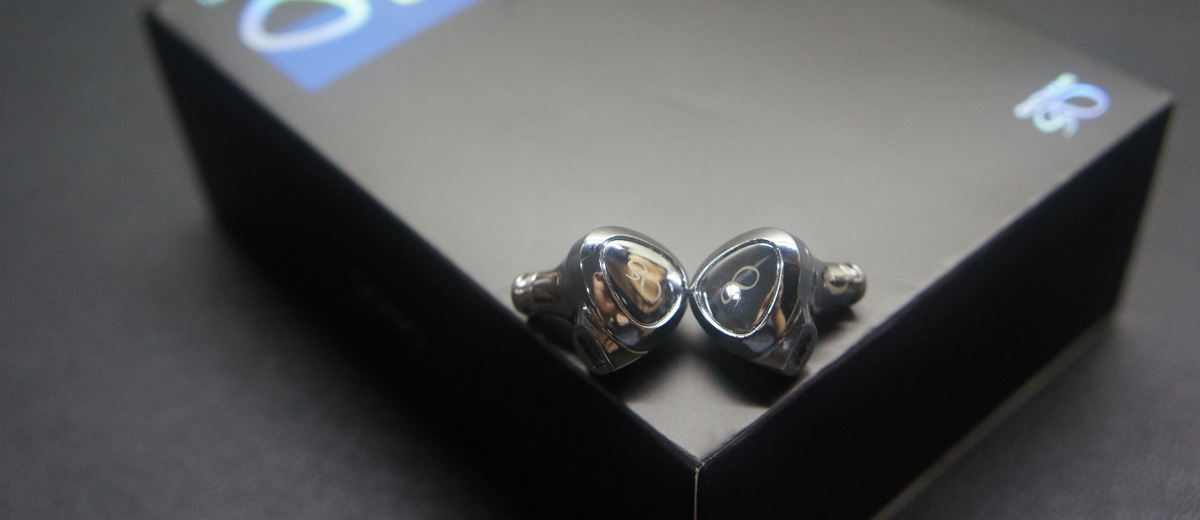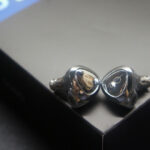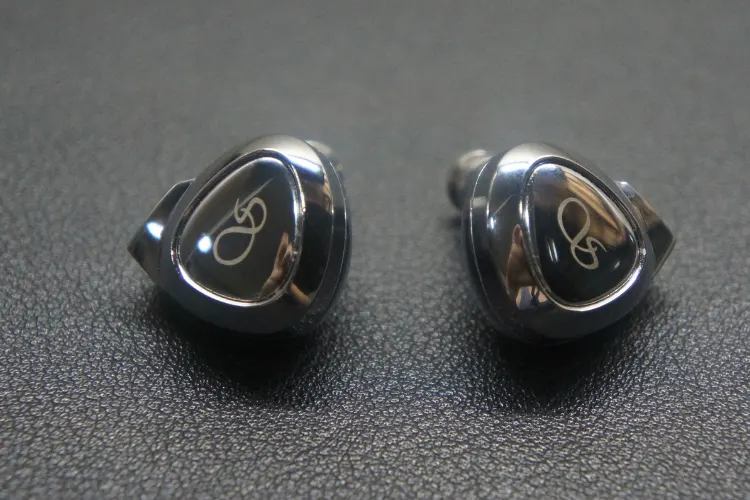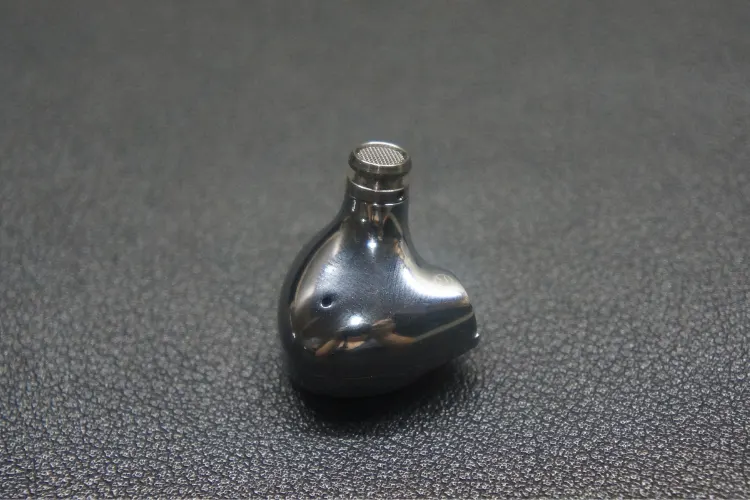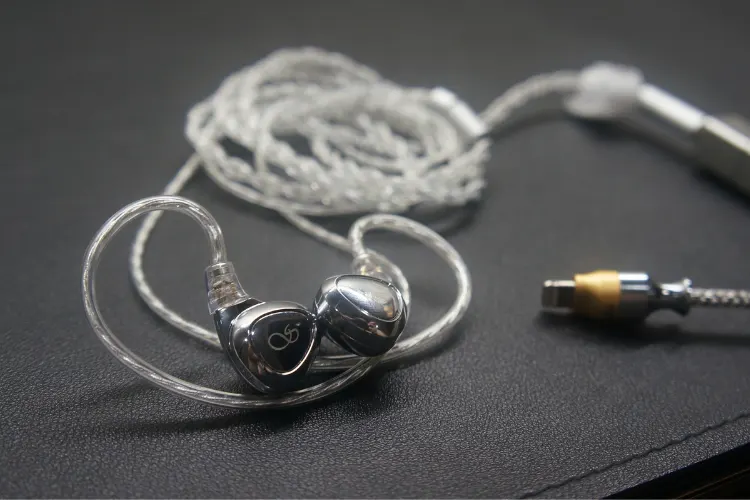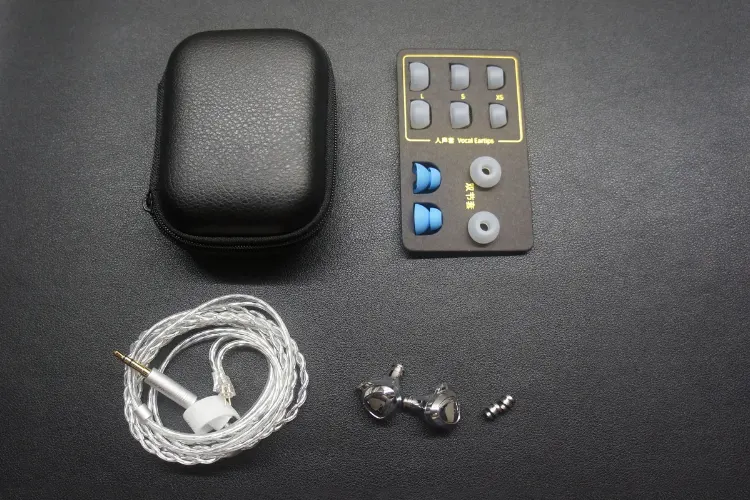Today, we review the Shanling SONO, which is a new entry-level hybrid triple-driver IEM featuring a dual dynamic and a single BA driver design. It is priced at $79.
Disclaimer: This sample was sent to us in exchange for our honest opinion. Headfonics is an independent website with no affiliate links or status. We thank Shanling for their support.
To learn more about Shanling products we previously discussed on Headfonics click here.
Note, that this article follows our latest scoring guidelines which you can read here.
Most audiophiles may be more familiar with the Chinese brand Shanling for their Digital Audio Players and DAC/AMP units such as the M1s and M0 Pro, but they have also released their fair share of pricier IEMs such as the MG800 and the MG600.
This time, they’re going in the completely other direction by releasing a hybrid triple-driver IEM for under $100. Upon first inspection, it looks like something out of a Cartier boutique, but let’s see if all that glitters is coming up as audible gold.
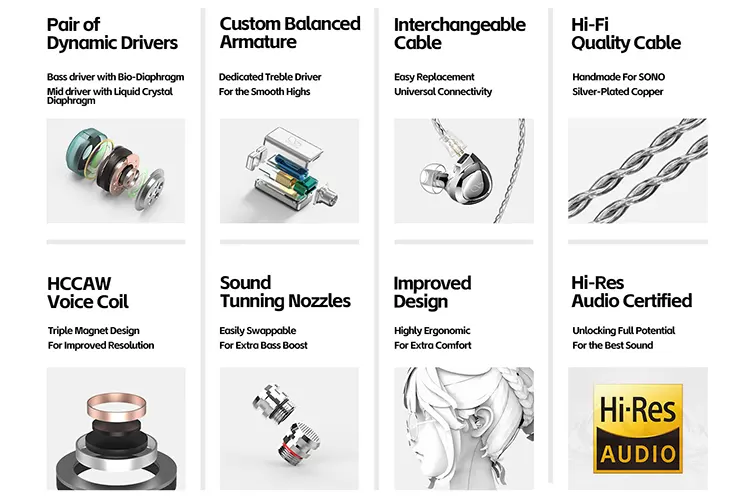
Tech Highlights
The Shanling SONO makes use of a hybrid configuration featuring 2 dynamic drivers in a coaxial configuration, with a 9.2mm Bio-diaphragm driver for the bass frequencies, and a 6.8mm LCD driver for the mid-range frequencies. The third driver is a custom Shanling BA driver responsible for the IEMs treble frequencies.
A standout at this price point is the full zinc alloy shell construction, giving it a dense, premium feel both in hand and during actual listening.
Another standout, regardless of price point, is the SONO’s use of easily replaceable tuning nozzles. Out of the box, it comes with 2 pairs of nozzles that are easily identifiable with the black or red stem that wraps around their base.
Design
The first thing you’ll notice about the SONO is the fact that it looks nothing like a typical sub-$100 IEM. It is a full zinc alloy construction that gives it a premium feel that resembles jewelry and high-end accessories.
I don’t wish to understate how exceptional the build quality is. To put this in perspective, this level of build quality at $200 would have been a pleasant surprise. But at $79, this kind of finish seems like a feat of engineering.
The shells do not have any sharp edges or corners since the metal is nicely contoured and shaped to have an unobstructed silhouette. Both left and right shells have a slightly indented faceplate that each has the Shanling logo on it.
The Zinc alloy is polished, giving it a mirror-like finish similar to the faceplate of the Moondrop Blessing 3. What is more impressive here is the fact that this finish is used on the entire shell and not just the faceplate.
Surprisingly, the SONO is not a fingerprint magnet, or at least not to the same degree as the Blessing 3. In my testing, I found that the shells are durable and quite resilient to micro-scratches.
The removable nozzles screw on easily and remain in place with good tolerances. The nozzles themselves seem to be constructed out of the same zinc alloy but are done so with a less glossy finish.
Comfort and Isolation
The Shanling SONO is comfortable to wear, thanks to its ergonomic shape and lightweight body. The earphone fits snugly in the ear canal and does not cause any fatigue or discomfort even after long listening sessions.
The earphone also provides decent isolation from external noise, although not as much as fully non-vented IEMs. The vented design allows some air to flow in and out of the earphone, which reduces the pressure build-up and enhances the soundstage.
The IEM’s comfort is quite average. They are less comfortable than my comfort benchmarks the Open Audio Witch Pro, but they are more comfortable than the slightly larger Kiwi Ears Quartet. They are quite close in comfort to the Tangzu FUDU, however, the FUDU’s DIVINUS tips give it a better in-ear feel.
I’m happy to report that the IEM’s zinc alloy build did not cause any weight-related discomfort, and I found them just as comfortable as the more common resin-based ChiFi IEMs within the price range.
It is important to highlight that there are two vents on each of the IEMs, one towards the rear of the shell, and one on the removable nozzle.
When attaching the included tips to the nozzle, users may accidentally cover up the nozzle. All potential buyers of the SONO must ensure that the tips are not blocking the nozzle vent since this leads to severely decreased bass response, making the IEMs sound lifeless and dull.
Stock Cable
The Shanling SONO comes with a silver-plated copper cable that is soft and flexible. The cable has four cores with 2 cores braided and housed in their own vinyl tube. These 2 vinyl tubes are then braided from the 3.5mm SE plug up to the metal chin splitter. After the splitter, each vinyl tube termites onto their own 2-pin connector.
The 2-pin connector on the stock cable is slightly different from most common styles. Each connector has a curved housing that matches the curvature of the IEM shell.
This gives the whole cable and IEM package a very premium feel. Other cables would fit, but it would come at the cost of the geometric cohesion of the out-of-the-box package.
Throughout my testing composed of on-the-go listening and desk usage, I observed no microphonics whatsoever and experienced no discomfort stemming from the cable.
Packaging & Accessories
The Shanling SONO comes in a simple black cardboard box with a stylized logo at the front. Opening the box shows the IEMs and all included accessories.
Aside from the IEMs themselves and the stock cable, the SONO comes with a compact leather hardshell case, a total of 4 ear tips (S, M, and L), and a pair of double-flanged blue ear tips.
The inclusions are not class-leading but are definitely above average. While not as impressive as the new accessory standard, the Tangzu FUDU, the included case is the best I’ve seen at the price point. And this is the first time I’ve seen double-flanged ear tips be included in an IEM.
Sound Impressions
Bass
The bass of the SONO hits deep with good texture retrieval. It doesn’t overstay its welcome and doesn’t drown out the rest of the frequency response. The bass still hits with good extension and impact, but not nearly as much as the red nozzle configuration.
I never found the bass quantity lacking, however, it is less warm than the other IEMs I’ve tried in the price range. The SONO doesn’t have the same thick velvety tonality, especially in the bass guitar region, that I hear with other IEMs such as the Kiwi Ears Quartet.
The bass never stands out on its own, but what it does do is satisfyingly playback bass frequencies that accentuate the overall tonality of the SONO.
Mids
The mids are articulated with good detail and resolution. One of the immediate standouts to me was the sheer detail retrieval I heard when it came to pianos and electric guitars despite the mids being recessed in the frequency response due to their V-shaped nature.
The upper mids region is where the SONO really begins to shine. Male vocals can seem quite dull, but female vocals are sparkly and energetic.
Treble
The treble region is where the SONO really stood out to me. They weren’t sibilant at all, but they did extremely well at detail retrieval. In rock music, they were able to play back hi-hats with a very good sense of decay.
Electric guitars that sound slightly warm with other IEM sound energetic with the SONO. I thoroughly enjoyed listening to rock music with the SONO since it’s able to accentuate the energy even in heavily layered tracks, without sounding fatiguing at all.
Imaging
The imaging of the Shanling SONO is good, in no small part due to its superior detail retrieval. The earphone can reproduce a good sense of directionality and positioning of different instruments and vocals on the soundstage.
I usually find that lower-cost IEMs with good imaging performance do not stage very well but the SONO seems to be an exception to this. The earphone can also create a good sense of layering and separation of different sounds in complex tracks.
Click on page 2 below for our recommended pairings and our selected comparisons.

